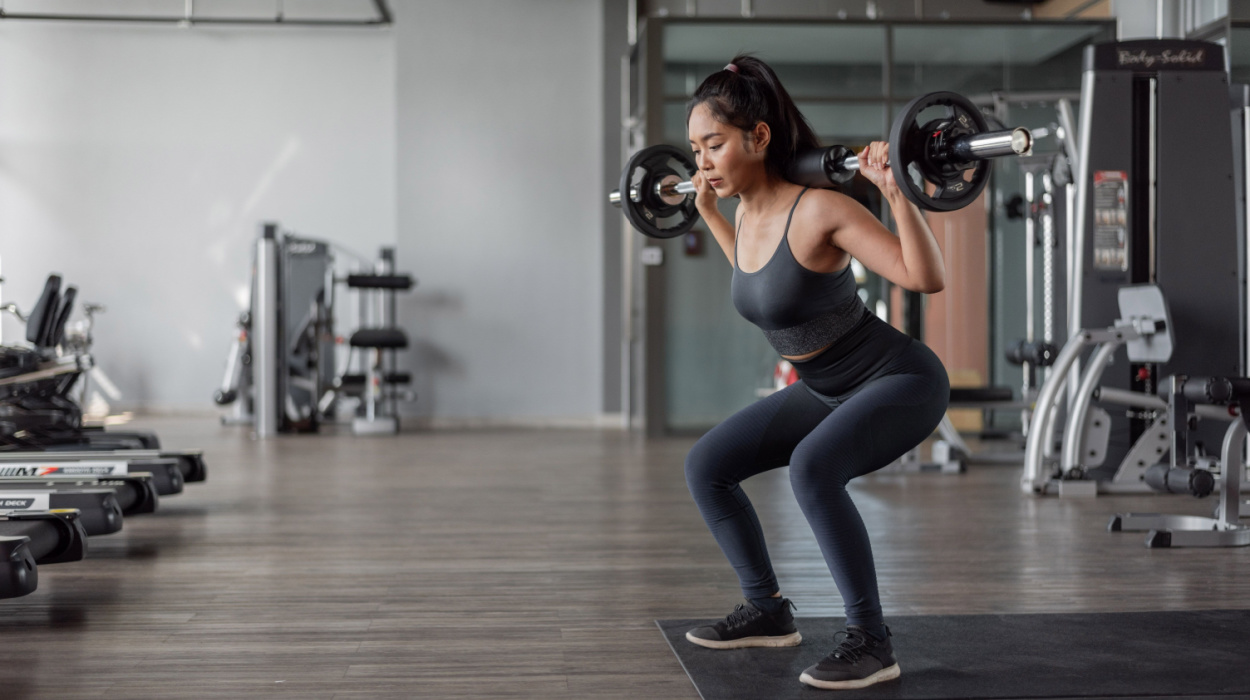Kicking off your journey to lose fat and gain muscle is about more than just tipping the scales — it’s a total body and health transformation. This tightrope walk of shedding fat while gaining lean muscle, called body recomposition, rests on nailing the perfect blend of diet, exercise, and lifestyle tweaks.
Whether you’re a fitness rookie or a gym veteran aiming to lower your body fat percentage and bulk up those muscles, this guide has got your back. Dive in for a complete playbook on losing fat and gaining muscle mass, designed for beginners and the fitness-savvy.
How To Lose Fat And Gain Muscle At The Same Time
To lose fat and gain muscle simultaneously, focus on these key strategies:
- Follow a nutrition plan rich in proteins and balanced in carbohydrates and fats.
- Engage in strategic strength training to build and tone muscles.
- Include effective cardio exercises to enhance fat burning.
- Prioritize adequate rest and recovery for muscle repair and growth.
- Regularly monitor progress and adjust your diet and workout intensity.
5 Ways To Lose Fat While Building Muscle Safely
As you set out to reshape your body, here are some safe and effective methods to lose fat while simultaneously building muscle:
Optimized Nutrition Plan

Crafting an optimized sports nutrition plan is fundamental in the journey to losing weight and gaining muscle. It should support your workout regimen and meet your body’s nutritional needs.
Balancing Macronutrients
Properly balancing macronutrients is essential for fueling muscle growth and effective fat loss:
- Proteins: The building block of muscles is a complete protein. Increase your lean body mass with lean protein sources like chicken, fish, tofu, legumes, and eggs. Your protein intake helps in muscle repair and growth, especially after strength training sessions.
- Carbohydrates: Choose complex carbs like whole grains, fruits, and vegetables, which provide sustained energy for workouts and aid in muscle recovery. Including fruits and vegetables in your diet ensures you get essential vitamins, dietary fiber, and minerals.
- Fats: Don’t avoid eating healthy fats in avocados, nuts, and extra-virgin olive oil. These are crucial for hormone production, impacting muscle growth and fat loss.
Caloric Intake And Deficit
To lose fat, you need to consume fewer calories than you burn. However, the caloric deficit shouldn’t be so large that it hampers muscle growth. Utilize tools like calorie calculators to estimate how many calories you need to achieve a caloric deficit and adjust based on your progress.
Meal Timing And Frequency
Eating smaller, balanced meals more frequently throughout the day can keep your metabolism active and energy levels stable. Post-workout nutrition is crucial – consuming protein and carbs after exercise can aid muscle recovery and growth.
Hydration
Water is key in metabolic processes and helps transport nutrients to the muscles. Staying well-hydrated is essential for both fat loss and muscle gain.
Supplementation
While whole foods should be your primary source of nutrients, fat-burning supplements, metabolism boosters, and omega-3 fatty acids can also be helpful as you try to achieve your goals. They can fill nutritional gaps and enhance your body’s ability to gain muscle and lose fat.
By adhering to these guidelines, your diet can effectively support your goal to promote fat loss and increase muscle gains. Regular monitoring and adjustments are vital to finding the perfect body balance. As you lose weight, calorie needs must be adjusted, and regular exercise will warrant an adjustment in frequency, intensity, and duration of workouts.
Strategic Strength Training

Strategic strength training is a cornerstone in the dual pursuit of losing fat and gaining muscle. It involves exercises that target various muscle groups, helping to increase lean muscle mass, and boosting your metabolic rate.[1] Here’s how you can implement a strategic strength training regimen:
- Compound Movements: Focus on exercises like squats, deadlifts, and bench presses that work for multiple muscle groups at once. They are really effective for building both strength and muscle mass.
- Bodyweight Movements: Exercises such as push-ups, planks, and lunges are great for those starting out or when equipment is unavailable. They help build a solid foundation for strength.
- Weight Training: Incorporating free weights or machines can further challenge your muscles, leading to growth and improved muscle tone. It’s key in the process to gain muscle while losing fat. Lifting weights strengthens your muscle fibers and helps you gain lean muscle mass.
- Progressive Overload: Gradually increase the weight of your workouts or heavy resistance training. This principle encourages continuous muscle growth[2] and strength gains. These gains alter your body composition to a more chiseled physique.
Effective Cardio Regimen
Cardiovascular exercises create a calorie deficit necessary for fat loss. The right cardio regimen can complement your strength training by burning fat without sacrificing muscle mass. Here’s how to effectively integrate cardio exercises into your routine:
- High-Intensity Interval Training: Short bursts of high-intensity exercises followed by rest or low-intensity periods characterize this form of training. HIIT is effective for burning many calories in a shorter time.
- Steady-State Cardio: Activities like jogging, cycling, or swimming consistently help burn fat and improve cardiovascular health. They can particularly benefit those asking, “Can you gain muscle while cutting fat?”.
- Circuit Training: Combining strength exercises with short bursts of cardio can keep your heart rate up, enhancing fat burn and muscle endurance.
- Low-Impact Options: For those with joint concerns or beginners, low-impact cardio, like walking or using an elliptical machine, can be a great start.
By combining strategic strength training with an effective cardio regimen, you create a powerful duo that helps decrease fat mass and gain muscle simultaneously and improves your overall fitness and health.
Adequate Rest And Recovery
In your quest to lose fat and gain muscle tissue, don’t underestimate the power of rest and recovery. During this downtime, your body repairs and strengthens itself, especially after intensive workouts.
Importance Of Sleep
Quality sleep is fundamental for muscle recovery.[3] During sleep, your body releases growth hormones aiding muscle repair and growth. Adequate sleep also helps regulate appetite hormones, which can help maintain a healthy diet for body recomposition. Aim for seven to nine hours of sleep per night to give your body ample time to recover and rejuvenate.
Active Recovery Days
Incorporate light activities like walking or yoga on your rest days. Active recovery helps maintain mobility and reduce muscle stiffness without overtaxing your body. They increase blood circulation, which aids in transporting nutrients to your muscles and removing waste products, thereby enhancing recovery.
Listening To Your Body
Pay attention to what your body tells you. If you notice that you are starting to feel fatigued or sore, it could be a sign to take a break or reduce the intensity of your workouts. This self-awareness prevents overtraining and injuries, ensuring a safe and sustainable path to reaching your fitness goals to lose weight.
Stress Management
High stress can impede your body’s ability to recover.[4] Make time for activities that allow you to relax, like zoning out in meditation or finding your zen with hobbies that unwind you. Stress management is vital to keeping your motivation and optimism on your fitness path.
Remember, recovery is just as important as the workout itself. You’re setting the stage for optimal performance in your workouts and paving the way for successful body recomposition efforts, especially in female athletes.
Regular Monitoring And Adjustments
Tracking your progress and then trying to make the necessary adjustments can help you understand how your body is responding and help you make informed decisions about your fitness plan.
Tracking Progress
Use methods like body measurements, progress photos, and strength milestones to track your progress. This multifaceted approach gives you a clearer picture of how your body is changing, going beyond just the number on the scale. Additionally, this regular documentation can be a motivational tool, showcasing your achievements over time and inspiring you on your journey.
Nutritional Adjustments
As your body changes, so do its nutritional needs. Be prepared to adjust your caloric intake and macronutrient balance. Regularly reassessing your diet ensures that you are fueling your body correctly for fat loss and muscle gain. It’s also important to remember that nutritional needs can vary based on workout intensity and lifestyle changes, making ongoing adjustments a key part of your fitness strategy.
Feedback And Adaptation
Listen to feedback from your body. If a certain type of workout isn’t yielding results or causing discomfort, be ready to adapt and try different approaches. This adaptive strategy helps avoid injuries and ensures that your fitness regimen remains effective and aligned with your changing goals and needs. Remember, what works today might need tweaking tomorrow, so stay flexible and responsive to your body’s cues.
By regularly monitoring your progress and being flexible in making adjustments, you can ensure that your journey to eat to lose fat and gain muscle remains effective and aligned with your evolving fitness goals.
Can You Lose Fat And Gain Muscle At The Same Time?
There are a lot of people out there who wonder whether it is possible to reduce body fat and promote muscle growth simultaneously. The truth is that meeting your body recomposition goals is definitely achievable, especially if you have a well-structured approach. As you start down the path, you must remember and fully understand that losing fat while gaining muscle requires a delicate balance of diet, exercise, and recovery.
Body recomposition is not about dramatic weight loss; rather, it’s about changing your body’s composition. This means reducing fat stores while increasing lean muscle. This might involve adjusting your strength training to focus more on hypertrophy (muscle growth) and incorporating specific cardio exercises that support fat-burning without muscle loss.
Nutrition plays a pivotal role here; eating enough protein to support muscle growth while maintaining a slight calorie deficit is key to losing fat.
Remember, body recomposition is a gradual process. It will require you to have patience and practice consistency. Your body needs time to adjust to new exercise routines and dietary changes. Monitoring your progress and making adjustments as needed will help you achieve your goal of losing fat and gaining muscle simultaneously.
Health Benefits Of Gaining Muscle And Losing Fat
Gaining muscle while losing fat offers a plethora of health benefits that extend beyond just aesthetic improvements. When you focus on building muscle, you’re enhancing your physical appearance and boosting your body’s overall health and functionality.
Gaining muscle does so much more for you than just changing how you look on the outside; it revs up your metabolism. With more muscle, your body burns calories even when relaxing or hanging out around the house. This helps you keep a healthy weight and trim down that body fat.
And let’s not forget about the perks of being stronger – better posture, improved balance, and you’re less likely to get hurt as you get older.
Losing fat while you’re at it is like a double win. It lowers your chances[5] of running into health troubles like heart disease, type 2 diabetes, and some cancers. Plus, when you’re leaner, you’ll likely feel more balanced hormone-wise and mentally. You might notice a boost in how good you feel about yourself and a drop in the blues or anxiety.
So, when you’re sweating it out in the gym or picking out your meals, it’s more than just about looking good. You’re taking steps towards a healthier, happier you. Getting the hang of eating right and building muscle will help a lot. It sets you up for a lifestyle that’s all about feeling great inside and out.
The Bottom Line
Figuring out how to lose fat and gain muscle at the same time is a task that combines nutrition, exercise, and lifestyle changes. With the right approach and a solid mindset, it’s a rewarding process that significantly improves your physical appearance and overall health.
Frequently Asked Questions
Balance a high-protein diet with strength training and regular cardio while maintaining a slight calorie deficit.
Focus on a balanced diet of protein, whole grains, and fruits and vegetables, minimizing processed foods and sugars.
Building muscle can increase your basal metabolic rate, leading to more efficient fat-burning.
 Evidence Based
Evidence Based
